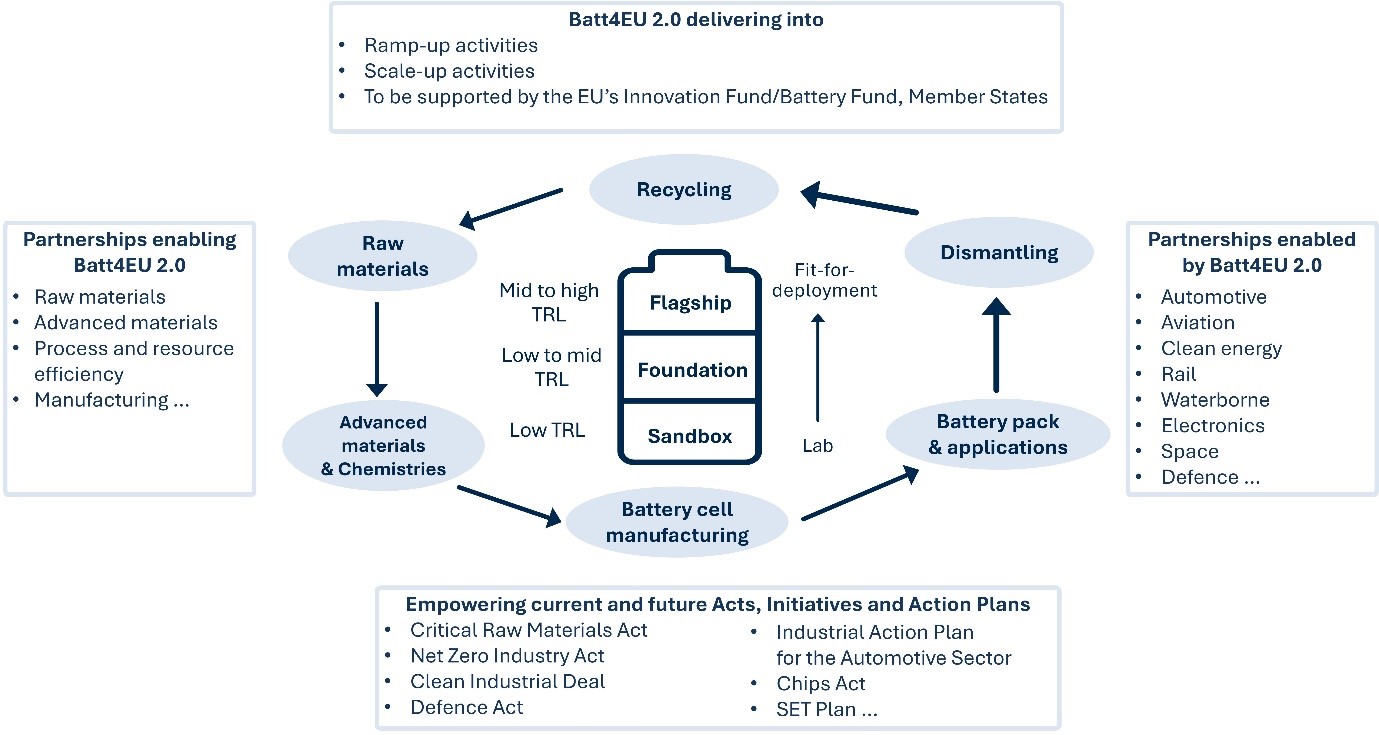To remain on the global battery map, Europe needs an ambitious competitiveness-driven battery innovation partnership in the next MFF
18 July 2025

Read BEPA's vision for the next battery partnership - BATT4EU 2.0.
Batteries are key to clean mobility, such as electric vehicles, but also stationary energy storage (for integration of renewables into the grid), our digital way of life, and energy-dependent defence technologies.
All these applications depend on the development of cost-effective, performant, sustainable and circular batteries. Competing with Asia in such a tough global arena is about innovating more, better, faster — or Europe will be out-innovated.
Against this backdrop, the European Commission set up under Horizon Europe, a public-private partnership to support R&I across the battery value chain. This battery partnership (called BATT4EU – Batteries for Europe) was one recommendation out of the EU’s Strategic Action Plan on Batteries, prepared with the European Battery Alliance.
To interact with the European Commission in running BATT4EU, the Batteries European Partnership Association (BEPA) was created in late 2020 to build a battery innovation ecosystem, to foster collaborative battery R&I, and to strengthen European innovation capabilities.
BEPA, the European battery R&I voice, today counts 240+ members, of which 50% come from industry (incl. 50+ startups). In the 2021 – 2024 period, BATT4EU channelled 514 million euros of Horizon Europe public funding to 85 projects involving 750+ beneficiaries. We have also demonstrated unlocking about 3 euros of in-kind additional activities from BEPA members for 1 euro of Horizon Europe public funding.
BATT4EU projects cover the full battery value chain (22% on raw materials and recycling, 25% on advanced materials and chemistries, 20% on battery cell manufacturing, 19% on end-applications for mobility, 14% for others) and also include community building projects such as “Batteries Europe” and “Battery 2030+”. Also, 10 out of the 85 projects are ending before April 2026 and will deliver results of value to industry.
Topic-wise, the partnership covers the development of affordable battery chemistries with less critical raw materials, and next-generation battery chemistries with higher performance, safety and competitiveness, such as solid-state batteries. We also support the design of less capital-intensive and more agile manufacturing processes, but also less energy-intensive and cleaner production processes. Digital tools for production lines and platforms for accelerated materials discovery are becoming important topics. Finally, BATT4EU also prepares for cost-optimised high-efficiency recycling of various complex feeds and innovates on battery sustainability.
Like all Horizon Europe partnerships, BATT4EU operates within a range of TRLs (technology readiness levels). 65% of current projects should reach TRL 4-5 (technology (pre-)development), while 35% should reach TRL 6-7 (technology demonstration).
The end goal is, of course, the first industrial deployment (TRL 8) and later full industrialisation of these technologies (TRL 9). This will require policies, instruments and public funding schemes that are, however, outside the scope of Horizon Europe.
Continuing to research and develop technologies from lab to fit-for-deployment stage (TRL 7) will require further R&I activities and ideally public funding within BATT4EU and in the EU’s next multiannual financial framework (MFF). Collectively, we have to run both an innovation sprint and an innovation marathon to build and maintain Europe’s competitiveness.
In the next MFF, for the period 2028 – 2034, BEPA therefore calls for the continuation of BATT4EU as a self-standing partnership (BATT4EU 2.0, see Figure 1) with more ambitious, effective, and efficient funding to safeguard innovation capabilities and keep Europe on the global battery map.

Figure 1. Outline of BATT4EU 2.0 – The next MFF’s battery partnership.
Through research and innovation, BATT4EU 2.0 will support the industry’s challenges related to the scope of operations and technologies, the scale of investments and their profitability, the speed of industrialisation and innovation, and the sustainability of operations and products.
Building on solid foundations, BATT4EU 2.0 will cover the battery value chain, and it will address the various battery chemistries for various relevant applications (road mobility, non-road mobility, stationary, electronics, defence, etc.). By tackling challenges under one roof, the battery partnership will ensure a coordinated and synergetic development of fit-for-purpose technology blocks needed for the Clean Industrial Deal.
To cover the relevant technology development from the lab to fit-for-deployment, we anticipate BATT4EU 2.0 to consist of a sandbox track (lower TRL, fewer partners, smaller projects, less prescriptive), a foundation track (replicating the success of BATT4EU) and a flagship track (higher TRL, fewer partners, bigger projects, more prescriptive). We believe this construction should facilitate and accelerate innovation while preparing for the future.
BATT4EU 2.0 will also build strong interfaces with relevant innovative partnerships, such as application-specific partnerships which rely on battery technology as one of the technology blocks to integrate into applications. Strong upstream and downstream interfaces will reduce fragmentation, unlock synergies, and deliver the highest return on public funds.
Finally, we believe that the BATT4EU 2.0 construction will best account for the diversity of the European battery ecosystem, to minimise the risks associated with technology development, market dynamics and value chain complexity. Optimising the “risk vs impact” ratio of public funding will enhance our chances of building battery technology leadership across multiple applications in Europe.
Europe and its industry need a strong battery partnership in the next MFF to support efforts for technological sovereignty, strategic autonomy, and resilience in battery technology – Let us do it!
For correspondence, please contact:
Fabrice STASSIN (Secretary General): f.stassin@bepassociation.eu
Wouter IJZERMANS (Executive Director): w.ijzermans@bepassociation.eu

